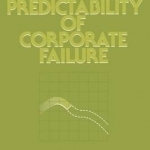Predictability of Corporate Failure: Models for Prediction of Corporate Failure and for Evalution of Debt Capacity
BookThis item doesn’t have any media yet
2012 | Home & Garden
1. 0 INTRODUCTION. In this chapter we define first in Section I. I the concept of failure used in this study. Thereafter, we discuss briefly the causes and possible consequ- ences of failure. Finally, we explain in Section 1. 2 the aim of this study. 1. 1 THE CONCEPT OF FAILURE. In this monograph we investigate the predictability of corporate failure. By 'failure' we understand the inability of a firm to pay its obligations when these fall due (i. e. technical cash insolvency). (Walter 1957 and Donaldson 1962 and 1969). Failure mostly appears in a critical situation as a consequ- ence of a sharp decline in sales. Such a decline can be caused by a recession, the loss of an important customer, shortage of a raw material, deficiencies of management, etc. The ability to predict corporate failure is important for all parties involved in the corporation, in particular for management and investors. An early warning signal of probable failure will enable them to take preventive measures: changes in operating policy or reorganization of financial structure, but also voluntary liquidation will usually shorten the period over which losses are incurred.
The possibility to predict failure is important also from a social point of view, because such an event is an indication of misallocation of resources; prediction provides opportunities to take corrective measures. (See also Lev 1974, p. 134). 1. 2 AIM AND OUTLINE OF THE STUDY.
Related Items:
| Published by | Springer-Verlag New York Inc. |
| Edition | Unknown |
| ISBN | 9781468471939 |
| Language | N/A |
Images And Data Courtesy Of: Springer-Verlag New York Inc..
This content (including text, images, videos and other media) is published and used in accordance
with Fair Use.
